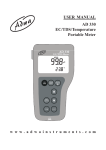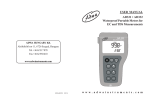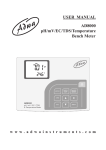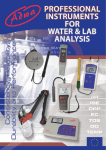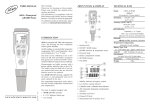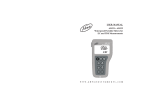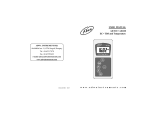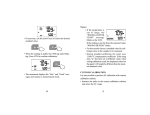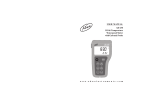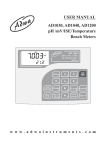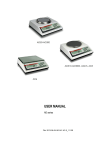Download USER MANUAL AD 3000 EC/TDS/Temperature Bench Meter
Transcript
USER MANUAL AD 3000 EC/TDS/Temperature Bench Meter w w w . a d w a i n s t r u m e n t s . c o m 1 Dear Customer, Thank you for choosing an Adwa product. Please read carefully this manual before starting operations. This instrument is in compliance with the EMC directive 2004/108/EC and its standards, and Low Voltage Directive 2006/95/EC and its standards for electrical equipments. For more technical information, please e-mail us at [email protected]. 2 TABLE OF CONTENTS Introduction ............................................................... 4 Technical Data .......................................................... 6 Front and Rear Panels ............................................... 8 Operational Guide ................................................... 10 Autoranging ............................................................. 13 Temperature Compensation .................................... 14 EC Calibration ......................................................... 16 Temperature Adjustment......................................... 21 Setup ........................................................................ 22 Good Laboratory Practice ....................................... 25 Log-on-demand ....................................................... 29 Hold ......................................................................... 33 Probe Maintenance .................................................. 34 Probes and Solutions ............................................... 35 3 INTRODUCTION AD3000 is a bench microprocessor-based conductivity, TDS and temperature meter. The autoranging feature of the EC and TDS ranges automatically sets the instrument to the scale with the highest resolution. Measurements are compensated for temperature effect automatically (ATC) or manually (MTC) with the conductivity probe with built-in temperature sensor. It is also possible to disable the temperature compensation and measure the actual conductivity. The temperature coefficient is user selectable. The instrument is equipped with a stability indicator, to indicate when measurement is to be recorded. AD3000 includes also GLP capability. In addition, the meter allows the user to enter an ID code to uniquely identify the instrument. 4 This model is supplied complete with: • AD76309 conductivity probe with built-in temperature sensor and 1 m cable • Calibration solutions at 1413 μS/cm and 12.88 mS/cm (20 ml sachet each) • 12 Vdc power adapter • User manual 5 TECHNICAL DATA Range 0.00 to 19.99 μS/cm; 0.00 to 9.99 ppm 20.0 to 199.9 μS/cm; 10.0 to 99.9 ppm 200 to 1999 μS/cm; 100 to 999 ppm 2.00 to 19.99 mS/cm; 1.00 to 9.99 ppt 20.0 to 199.9 mS/cm; 10.0 to 99.9 ppt -9.9 to 120.0 °C Resolution 0.01, 0.1, 1 μS/cm; ppm 0.01, 0.1 mS/cm; ppt 0.1 °C Accuracy ±1% f.s. (EC/TDS) (@25 °C/77 °F) ±0.5 °C EC Calibration Offset at 0.00 μS/cm; Slope at 1 point with 6 memorized values (84.0, 1413 μS/cm; 5.00, 12.88, 80.0, 111.8 mS/cm) or with custom value Temperature Automatic or manual, Compensation -9.9 to 120 °C Temperature Selectable Coefficient from 0.00 to 10.00%/°C TDS Factor Selectable from 0.40 to 1.00 (default value: 0.50) 6 Reference Temperature Selectable from 15.0 to 30.0 °C Log-on-demand Up to 250 samples Probe (included) AD76309 EC probe with built-in temperature sensor Power Supply 12 Vdc power adapter Environment 0 to 50 °C RH max 95% non-condensing Dimensions 230 x 180 x 50 mm Weight 1.8 kg 7 FRONT AND REAR PANEL Front Panel Rear Panel 8 1. Liquid Crystal Display (LCD) 2. STORE/RECALL key, to store measurements and recall stored data 3. CFM key, to confirm values 4. CAL key, to enter/exit calibration mode 5. Up arrow key, to manually increase the value of temperature or other parameters 6. Down arrow key, to manually decrease the value of temperature or other parameters 7. SHIFT key, to activate the key alternate function. Press and hold first the SHIFT key and then the second desired key 8. SETUP key, to enter/exit setup mode 9. RANGE/”lock” key, to select measurement unit or switch the focused data, and to freeze current range on the LCD 10. ON/OFF key, to turn the instrument ON and OFF 11. HOLD/GLP key, to freeze the first stable reading on the LCD and to display Good Laboratory Practice information 12. Power supply socket 13. Probe connector 9 OPERATIONAL GUIDE CONNECTIONS • Plug the 12 Vdc adapter into the power supply socket. Note: These instruments use non volatile memory to retain the calibration parameters and all other settings even when unplugged. • Connect the probe to the 7-pin connector. Tighten the threaded ring and make sure the probe sleeve is properly inserted, as shown below: INSTRUMENT START-UP • Turn the instrument on by pressing the ON/OFF button. • All LCD tags are displayed and a beep is generated while the instrument performs a self test. 10 TAKING MEASUREMENTS • Immerse the probe into the solution to be tested. The sleeve holes must be completely submerged. • Tap the probe repeatedly to remove any air bubbles that may be trapped inside the sleeve. • If needed, press RANGE until the desired EC or TDS range is selected on the LCD. • Allow for the reading to stabilize. The primary LCD displays the measurement in the selected range, while the temperature is displayed on the secondary LCD. 11 Notes: • If the meter displays only dashes "----", the reading is out of range. • If the stability indicator (hourglass symbol) blinks, the reading is not stable. • Make sure the meter is calibrated before taking measurements. • If measurements are taken successively in different samples, for accurate reading it is recommended to rinse the probe thoroughly with deionized water before immersing it into the sample. • TDS reading is obtained by multiplying the EC reading by the TDS factor, which has a default value of 0.50. It is possible to change the TDS factor within the 0.40 to 1.00 range by entering setup mode and selecting the "tdS" item (see “Setup” section for details). 12 AUTORANGING The EC and TDS scales are autoranging. The meter automatically sets the scale with the highest possible resolution. By pressing SHIFT and ”lock” keys, the autoranging feature is disabled and the current range is frozen on the LCD. The μS, mS, ppm or ppt tag (depending on the selected measurement mode and range) starts blinking. To restore the autoranging option press the SHIFT and ”lock” keys again. Note: Autoranging is automatically restored if range is changed, if setup or calibration mode is entered, or if meter is turned off and back on again. 13 TEMPERATURE COMPENSATION Three options are available for temperature compensation: 1. Automatic (ATC): the EC probe features a built-in temperature sensor, which provides the temperature reading to automatically compensate the EC/TDS measurement (from -9.9 to 120.0°C), also using the selected reference temperature. 2. Manual (MTC): the temperature value can be manually set using the arrow keys. The compensation is referenced to the selected reference temperature. While in MTC mode, the °C tag blinks on the secondary LCD. 3. No compensation (NOTC): the temperature is not taken into account. The reading displayed on the primary LCD is the actual EC or TDS value. Notes: • The default compensation mode is ATC. • Temperature compensation setting can be accessed by entering the setup mode and selecting the "tcE" item (see “Setup” section for details). 14 • If the temperature compensation is active, measurements are compensated using the temperature coefficient (default value 1.90 %/°C). To change the temperature coefficient, enter the setup mode and select the “tc” item (see “Setup” section for details). • If the temperature reading is out of the -9.9 to 120.0 °C interval and the ATC option is selected, the temperature full scale value will be displayed, together with the °C tag blinking. No temperature compensation will be performed. • The reference temperature can be set from 15 to 30 °C. When the reference temperature is changed, the temperature coefficient must be manually adjusted by the user. For example, if α is the coefficient with reference temperature of 25 °C, if changing the temperature to 20 °C, the new coefficient can be calculated with the following formula: β=α/(1-α/20) If α=1.90%/°C, then β=2.10%/°C. • Always set reference temperature to 25 °C when measuring TDS. 15 EC CALIBRATION STANDARD CALIBRATION EC calibration is a one-point procedure. Selectable calibration points are: 0.00, 84.0 and 1413 μS/cm, 5.00, 12.88, 80.0 and 111.8 mS/cm. • Rinse the probe with calibration solution or deionized water, then immerse it into the solution. The sleeve holes must be completely submerged. • Tap the probe repeatedly to remove any air bubbles that may be trapped inside the sleeve. • To enter EC calibration, select the EC range and press CAL key. Note: TDS readings are automatically derived from the EC readings and no specific calibration for TDS is needed. Pressing CAL when TDS range is selected has no effect. • For zero calibration, simply leave the dry probe in the air. The "CAL" and "BUFFER" tags light up. 16 • The primary LCD displays the not calibrated EC reading, while the secondary LCD shows one of the available standard values. The hourglass symbol blinks. • If necessary, use the arrow keys to select the desired standard value. • When the reading is stable, the CFM tag starts blinking. Press CFM to confirm calibration. • The instrument displays the "Stor" and "Good" messages and returns to measurement mode. 17 Notes: • If the temperature is out of range, the "WRONG BUFFER TEMP" message blinks on the LCD. If the reading is too far from the expected value, "WRONG BUFFER" blinks. • For best results choose a standard value for calibration close to the sample to be measured. • During standard calibration the meter uses 1.90%/°C compensation coefficient . If the setup item "tc" has been set to different value, when exiting calibration mode, the displayed valued on the upper LCD might be different from the nominal standard value. CUSTOM CALIBRATION It is also possible to perform EC calibration with custom calibration solution. • Immerse the probe in the custom calibration solution and select the EC range. Press CAL to enter the EC calibration and then the RANGE key to enter custom EC calibration mode. 18 • The "CAL", "BUFFER" and "Cal Point Custom" tags light up. The primary LCD displays the not calibrated temperature compensated EC reading, while the secondary LCD shows the temperature compensated EC reading, factory calibrated with k=1. The hourglass symbol blinks. • Using the arrow keys, adjust the EC reading on the primary LCD to the desired value. • The maximum adjustment is ± 40% around the secondary LCD reading. • When the reading is stable, the CFM tag starts blinking on the LCD. Press CFM to confirm calibration. • The instrument displays the "Stor" and "Good" messages and returns to measurement mode. 19 Notes: • Zero calibration is not allowed in custom mode. • The calibrated custom value is considered the value of the calibration solution at the selected reference temperature. • It is possible to set the cell constant value directly, without following the calibration procedure. To set the cell constant enter the setup mode and select the "CELL" item (see “Setup” section for details). • The temperature reading is not used during custom EC calibration. 20 TEMPERATURE ADJUSTMENT The temperature reading can be manually fine-tuned following the next procedure. Press SHIFT and CAL keys to enter the temperature adjustment mode. Both primary and secondary LCDs will display the factory default temperature reading. Adjust the temperature reading on the primary LCD using the arrow keys. The maximum adjustment is ±1.0ºC around current reading. Press CFM to confirm. The meter returns to measurement mode and displays the new temperature. Notes: • Press SHIFT and CAL keys to escape without any changes. • To enter temperature adjustment mode, the probe must be connected and the meter must be in ATC mode. 21 SETUP Setup mode allows to view and modify the instrument parameters. To enter setup mode, press SETUP key from measurement mode. The SETUP tag lights up. The primary LCD will display the temperature coefficient (default value 1.90%/ ºC), while the secondary LCD shows the code of the current setup item. Select the desired setup item using the arrow keys, then press CFM to select and edit the setup item value, and its current value starts blinking (if it is a changeable parameter). 22 Press the arrow keys to change the value. If there is another part of the item to be set (e.g. month in setting up the current date), press RANGE and the part to be changed will start blinking. Press the ARROW keys to change the value and CFM to confirm. Note: Press SETUP key before confirmation to escape without changing the previously set value. 23 The following table lists the setup items, their valid range and the factory settings (default): Item Description tc tcE Temp.compensation coeff. 0.00 to 10.00% / ºC Temp.compensation mode Atc, Mtc, notc rEF Reference temperature 15.0 to 30.0 ºC 25.0 ºC tdS TDS factor 0.40 to 1.00 Valid values CELL Cell constant (K) 0.500 to 1.700 bEEP Beep on key pressed On, Off YEAr Year 1999 to 2098 DATE date (DD.MM) 01.01 to 31.12 TIME Time (hh:mm) 01:01 to 23:59 id Meter identification code vEr firmware release 24 0000 to 9999 Default 1.90 Atc 0.50 1.000 On 0000 GOOD LABORATORY PRACTICE Good Laboratory Practice (GLP) is a set of functions that allows storage and retrieval of data regarding the status of the system. After a successful calibration, the meter automatically stores the date and time of calibration, the used calibration solution and the resulting cell constant value. All this information can be recalled by the user. To view the last calibration data, press SHIFT and GLP keys. The first information appearing on the LCD is the meter "id" code. By repeatedly pressing RANGE key, all GLP data are displayed as shown in the next pages. 25 Last calibration date (day and month): Last calibration date (year): Last calibration time: 26 Cell constant value (K): If standard calibration solution was used: If custom calibration solution was used: If the cell constant was changed after calibration (through the "CELL" setup function), this information is not displayed. 27 If RANGE is pressed when the last parameter is displayed, the meter returns to measurement mode. Notes: • To exit GLP mode at any time press SHIFT+GLP keys. • If the calibration procedure was never performed, after displaying the ID code, the LCD will show the "no CAL" message blinking. Press RANGE or SHIFT+GLP keys to return to measurement mode. • Last calibration data is available for EC range only. No calibration data can be recalled for TDS. If the meter is in TDS mode, by pressing SHIFT+GLP keys only the ID code is shown. Press SHIFT+GLP keys again to return to measurement mode. • The meter is provided with an internal lithium battery that allows to correctly update date and time even if the power supply is disconnected. • GLP data are not affected by the zero calibration. 28 LOG-ON-DEMAND To store the current reading into memory, press STORE key while in measurement mode. The LCD will display for a few seconds the "Stor" message together with the "LOG" tag and the sample number. By pressing the STORE key a complete set of information is memorized: date, time, EC, TDS and temperature readings. Up to 250 samples can be stored into memory. When the memory is full and the STORE key is pressed, the sample will not be stored and the LCD will display the "FULL" message. In this case, it is necessary to delete all data from memory to proceed. 29 TO VIEW STORED DATA To retrieve the memorized information, press SHIFT+RECALL keys. The primary LCD displays the date (day and month) and the secondary LCD shows the last stored sample number. If no samples are stored into memory, the "ZERO" indication is displayed. • Select the desired sample number using the arrow keys. If the up arrow key is pressed while the last sample is displayed, the meter returns to the first sample. • Press RANGE to view the remaining data for the selected sample in the following order: • year 30 • time • EC or TDS reading (only dashes "----" means reading out of range or probe not connected) • Temperature reading (only dashes "----" means reading out of range) • To skip to the next or previous sample, use the up or down arrow keys respectively. For example, if the up arrow key is pressed while a sample reading is displayed, the meter shows the reading of next sample. • To return to normal measurement mode, press the SHIFT+RECALL keys at any time. 31 TO DELETE STORED DATA The meter allows to delete a single sample or all the memory at one time. To delete a single sample proceed as follows: • Enter the viewing stored data mode and select the desired sample number. • Press the HOLD key. "dEL" and "CFM" will start blinking. • Press CFM to confirm deletion. Note: Press HOLD key again to escape without deleting data. When scrolling through stored data, if a deleted sample is selected, the meter will display the "nuLL" message. To delete all data in memory: • Enter the viewing stored data mode. • Press SHIFT+HOLD keys. "dEL" and "CFM" will start blinking and the "ALL" message is displayed on the secondary LCD. • Press CFM to confirm deletion. 32 Note: Press SHIFT+HOLD keys to escape without deleting data. If no samples are stored in memory and a deletion is attempted, the meter shows the "Zero" message and then returns to measurement mode. HOLD To freeze the first stable reading on the LCD, press the HOLD key from measurement mode. The "Auto" and " H" tags will blink on the LCD until the reading is stabilized. When the reading becomes stable, the "Auto" and "H" tags stop blinking and the reading is frozen. Press the HOLD key again to return the normal measurement mode. 33 PROBE MAINTENANCE After measurements, rinse the probe with clean water. If a more thorough cleaning is required, remove the probe sleeve and clean the probe with a cloth or a non-abrasive detergent. Make sure to reinsert the sleeve onto the probe properly and in the right direction. After cleaning the probe, recalibrate the instrument. 34 PROBES AND SOLUTIONS AD76309 Conductivity probe with built-in temperature sensor and 1 m cable AD70031P 1413 μS/cm EC standard solution, 20 ml sachet, 25 pcs. AD70030P 12.88 mS/cm EC standard solution, 20 ml sachet, 25 pcs. AD70032P 1382 ppm TDS standard solution, 20 ml sachet, 25 pcs. AD7031 1413 μS/cm EC standard solution, 230 ml bottle AD7030 12.88 mS/cm EC standard solution, 230 ml bottle AD7032 1382 ppm TDS standard solution, 230 ml bottle AD7033 84 μS/cm EC standard solution, 230 ml bottle AD7034 80.00 mS/cm EC standard solution, 230 ml bottle AD7035 111.80 mS/cm EC standard solution, 230 ml bottle AD7039 5000 μS/cm EC standard solution, 230 ml bottle 35 ADWA INSTRUMENTS Kft. Alsókikötõ sor 11, 6726 Szeged, Hungary Tel. +36 62 317 878 Fax +36 62 550 610 e-mail: [email protected] www.adwainstruments.com MANAD3000 09/14 36





































